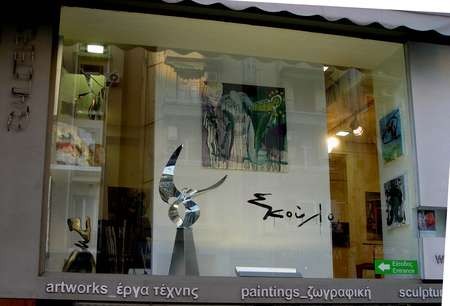The Spirit of Hermes sculpture at the Art Forum Gallery in Thessaloniki

The sculpture is 120 cm's high.
How did Masaaki become so involved in Greek culture?
Masaaki was introduced to Greek culture, and the work of Lacadio Hearn, through Art Collector, Takis Efsathiou.
Masaaki first met Lafcadio Hearn's grandson, Bon Koizumi at the Matsue Muesum, in Japan on July 5th 1996.
Takis Efstathiou organized Masaaki's first one person exhibition at the gallery Cyclades Antiebs in France in1995. At this time Masaaki travelled to Greece for the first time.
He visited Takis holiday house at Coulf, and then travelled to Lefkatha, Delfi and Athens. This visit had a profound infuence on his life and art, and began his involvement with Lafcadio Hearn, Greek culture, and Greece.
Takis Efstathiou then visited Japan for the first time. Together, in 1996 they organsised the Theodoros Stamos exhibition at the Hiro Gallery in Tokyo. Stamos was very keen to visit Japan, as Japanese culture exerted a great influence on his life and work. Stamos created drawings and brush stroke painting such as the "Tea House", which display an obvious Japanese influence. Stamos was ill, unfortunately, and was soon thereafter hospitalized. He could not risk a visit to Japan.
Masaaki enticed Takis Efstahiou to visit Tokyo, Kyoto, Osaka, Okayama, Hiroshima and Matsue. Takis became deeply involved with Japanese culture after this visit.
They have worked together since on a number of cultural projects, including the dedication of superb and significant sculptures to various Greek cities, which have resulted in a strengthening of the relationship between Greece and Japan.
New York Time Obituary of Theodoros Stamos
Theodoros Stamos, 74, Abstract Painter, Dies
By ROBERTA SMITH
Published: February 04, 1997
Theodoros Stamos, a precocious member of Abstract Expressionism's first generation and a prominent figure in a trial that rocked the art world in the 1970's, died on Sunday at the Hatsikosta Hospital in Yiannina, Greece, which he entered 12 days ago. He was 74 and lived in Manhattan and on the island of Lefkada, Greece.
He died of a lung ailment, said Takis Efstathiou, a friend.
Mr. Stamos was never considered an Abstract Expressionist of the first rank, and was nearly a generation younger than its chief innovators. But he committed himself to painting while still a teen-ager and was among the style's earlier adherents. He was also a close friend to many Abstract Expressionist artists, most famously Mark Rothko.
When Rothko committed suicide in 1970, Mr. Stamos had been named one of the three executors of his estate, along with Bernard J. Reis, an accountant, and Morton Levine, a professor of anthropology. In 1971, guardians acting on behalf of Rothko's children filed a petition against the executors charging that they had sold a large group of paintings to Rothko's representative, Marlborough Gallery, at an unusually high discount that was detrimental to his reputation, and that they were wasting the assets of the estate. The petition demanded their dismissal and cancellation of the contracts with Marlborough.
The petition noted that Mr. Reis was an officer of the gallery, and that Mr. Stamos was invited to join the gallery around the time of the sale. He had an exhibition there in 1972. The case eventually led to an eight-month trial that concluded in 1975, when Surrogate Millard A. Midonick ruled that Mr. Stamos and the other executors were guilty of negligence and conflict of interest. He dismissed them, canceled the contracts with Marlborough and levied $9.2 million in fines and assessments. Mr. Stamos paid his share by signing over to the Rothko estate his house, valued at $435,000, although Judge Midonick awarded him a life tenancy.
Mr. Stamos's reputation never recovered. He continued to exhibit his work in New York City, but less frequently, and at less prestigious galleries. His most recent exhibition was at the ACA Gallery in 1992. Nonetheless he exhibited often in other parts of the world, especially in Greece. For an exhibition at the Hiro Gallery in Tokyo in 1996 the biographical data chronicled his involvement with Rothko, his estate and the outcome of the trial.
Theodore Stamos was born in Manhattan on Dec. 31, 1922, the son of Greek immigrants who ran a hat-cleaning and shoeshine shop near St. Mark's Place. He began to draw while recovering from a ruptured spleen at the age of 8. He attended Stuyvesant High School where he studied art, mostly sculpture, for three years, quitting in 1939 just three months before graduation.
During the 1940's, Mr. Stamos supported his painting by running a small frame shop on East 18th Street in Manhattan where his customers included such artists as Arshile Gorky and Fernand Leger. He had his first solo show in New York at the Wakefield Gallery/Bookshop, run by Betty Parsons, who would later become a prominent dealer for Abstract Expressionists.
He was included in the 1945 Whitney Biennial; in 1946, the Museum of Modern Art acquired one of his paintings. The Modern also included his work in its legendary touring exhibition ''The New American Painting,'' which introduced Abstract Expressionism to European audiences in 1958 and '59. Between the late 1940's and 1970, Mr. Stamos exhibited regularly in New York, first with Ms. Parsons and then with Andre Emmerich.
Mr. Stamos's artistic style coalesced in the late 1940's and involved muted colors and soft-edged organic shapes somewhat influenced by the work of Milton Avery and William Baziotes. It was a style that he adhered to for the rest of his life, sometimes paring down the shapes to glowing fissures of color. Its strengths lay in its sense of muffled light and its sensitive, modulated surface. In the late 1980's, these surfaces turned thick and lunar and at times the lines of color would be backed by relaxed, squarish shapes reminiscent of Rothko's compositions.
Mr. Stamos's work is represented in public collections around the world.
He is survived by three sisters, Georgina Savas and Chrisula Venetsianos, of Manhattan, and Kostas Stamastelos.